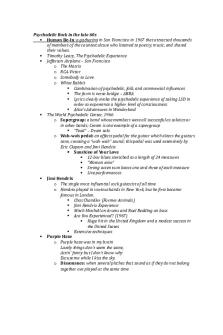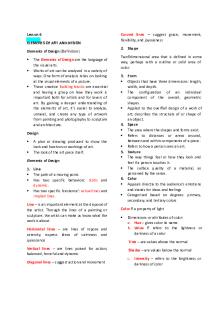Music Appreciation Midterm Study Sheet PDF

| Title | Music Appreciation Midterm Study Sheet |
|---|---|
| Author | Macy Martin |
| Course | Music Theory |
| Institution | Illinois State University |
| Pages | 4 |
| File Size | 148.6 KB |
| File Type | |
| Total Downloads | 29 |
| Total Views | 132 |
Summary
Midterm Study Guide...
Description
MUS 121 MUSIC APPRECIATION University of Illinois Springfield Midterm Exam Review Sheet Mar 22-26, 2017 This study guide is not a cumulative or complete guide for the midterm exam. Rather, it is intended to help direct your studying by serving as a reminder of major vocabulary, themes and ideas. Focus your energy on clarifying your understanding of the development of Western art music from the Middle Ages to the Baroque Era. In essay format, can you write about the changes that took place in Europe in the three different eras? Can you write about the development of Western art music from the Middle Ages through the Renaissance to the Baroque Era and incorporate vocabulary from the course? Unit 1: The Elements of Music Vocabulary rhythm, beat, accent meter, duple meter, triple meter, measure, syncopation tempo, metronome, allegro, andante instruments/4 sections of the orchestra amplified, resonator pitch, frequency dynamics, amplitude, forte, piano, subito tone color, timbre, overtones scale, diatonic, chromatic interval, octave melody harmony, consonance, dissonance texture, monophony, homophony, polyphony imitative polyphony, nonimitative polyphony tonality, tonic mode, major, minor key (i.e. a major, c minor) chords musical form (i.e. a b a) genre (i.e. symphony, opera, motet)
Major Ideas Why study Western art music? What is Western art music? Familiarity with musical concepts and terms help you grasp what you already hear Fundamental elements of music related to time Fundamental properties of sound especially pitch, dynamics, tone color Role of repetition and contrast in shaping our understanding of a piece Connection of memory and anticipation with musical meaning
Unit 2: The Middle Ages & The Renaissance The Middle Ages: The Age of Faith; The Dark Ages- slow development of art, science, thought. Dominance of Catholic Church. Principal styles including plainchant, secular songs, Notre Dame organum and ars nova. The music reflects life in the church and in court. Evolution of polyphony and rhythmic notation in the Middle Ages as found in organum, ars nova, motets, rounds and chansons. Vocabulary The Middle Ages (450-1450) plainchant/Gregorian chant, the liturgy reciting tone; medieval modes antiphon melisma sequence Hildegard von Bingen troubadours, trouveres Bernart de Ventadorn Organum, evolution of polyphony Perotin, Notre Dame School, notation system Motet Round Ars antiqua Ars nova, isorhythm Guillaume de Machaut Chansons
PIECES TO KNOW 1. Plainchant: “In paradisum” 2. Hildegard of Bingen: “Columba aspexit” 3. Perotin: “Alleluia diffusa est gratia” 4. de Ventadorn: La Dousa Votz 5. de Machaut: Dame de qui toute ma joie vient”
Be ready to discuss basic characteristics/significance of each work
The Renaissance: Decline of the power of the Catholic Church. The Rise of Humanism, a rebirth of ancient Greek ideals, the Protestant Reformation, questioning “why” and great changes in ways of life and belief systems. Principal music genres reflect a more humanist attitude that takes pleasure in the sounds and expressive possibilities of music. Harmonized hymn; mass; chanson; madrigal; dance music. Expressive techniques like declamation and word painting. The Renaissance 1450-1600, rebirth, decline of church, Humanism, Protestant Reformation, great changes Sacred music of early Renaissance; paraphrase, homophony, Plainchant harmonization, Hymn Freedom from strict rules of plainchant, relaxed attitude PIECES TO KNOW Guillaume Dufay 1. DuFay: “Ave maris stella” New music for liturgy- large newly-composed works! 2. Josquin: “Pange Lingua Mass” Set the Mass to new music 3. Josquin: “Mille regrets” [Kyrie, Gloria, Credo, Sanctus, Agnus Dei] 4. Palestrina: “Pope Marcellus Mass” Musical characteristics: imitation, homophony, 5. Weelkes: “As Vesta Was from Latmos Hill even tempo and dynamics, smooth, a cappella Descending” Giovanni Palestrina, musical response to 6. Anonymous: “Kemp’s Jig” counter-reformation Secular Music; Vocal = Motet; Madrigal; Be ready to discuss basic Instrumental = pavan, galliard, jig characteristics/significance of each work Declamation Word painting Thomas Weelkes Josquin Desprez
Major Ideas Decline of the Middle Ages (events i.e. Black Death, decline of Feudalism, Western Schism) Role of music in church Role of music at court/popular song How did early music sound? Principal styles of the Middle Ages—plainchant, secular songs, Notre Dame organum, ars nova Evolution of polyphony and rhythmic notation Basic characteristics of the Renaissance Renaissance music reflect humanist ideals Musical genres of the Renaissance (harmonized hymn, mass, chanson, madrigal, dance music) Expressive techniques of Renaissance music (i.e. declamation and word painting)
Unit 3: The Baroque Era Baroque Era: Interest in human emotions. Absolutism, extravagance and theatricality versus science and systematic control. Dominance of church, court and opera house. Rise of instrumental music with emphasis on the scientific expression of emotion and form like ritornello form (contrast and return), fugue (imitation), Baroque dances (repetition and contrast). New organization; features of instrumental works; new genres (concerto/concerto grosso). Vocabulary Baroque (1600-1750) Italy (Venice), Germany barroco Absolutism Church, court, opera house Baroque Era, dates, characteristics Vocal music characteristics (i.e. no longer a cappella; emotional expression is key) Giovanni Gabrieli Rhythmic drive, ornamentation, dynamics, melody, texture, repetition and contrast sequence Science and music, emotions Baroque orchestra, baroque festive orchestra Rise of opera, patrons- main vehicle of Baroque absolutism PIECES TO KNOW Recitative, purpose/musical characteristics Aria, purpose/musical characteristics 1. Gabrieli: “O Magnum mysterium” Claudio Monteverdi 1567-1643 2. Vivaldi: Violin Concerto in G Op. 4 No. Rise of instrumental music 12, I “La Stravaganza” Dance suites, gigue 3. Bach: Brandenburg Concerto No. 5, I Genre, form [Concerto, concerto grosso, movement] 4. Bach: The Well-Tempered Clavier, Ritornello form Prelude and Fugue in C Major Antonio Vivaldi 5. Bach: Gigue from Cello Suite No. 2 in D Johann Sebastian Bach 1685-1750 minor Cadenza 6. Monteverdi: The Coronation of Prelude Poppea “Tornerai?” Fugue, exposition [subject], entry, episode, countersubject, “Speranza, tu mi vai” inversion, stretto Glenn Gould Be ready to discuss basic Major Ideas characteristics/significance of each work Era of contradiction, Contradictory trends in music Venice, St. Mark’s Basilica Characteristics of musical style (i.e. driving rhythm, complex melody, ornamentation Rise of instrumental music
Development of the orchestra, development of instruments Extravagance and control, strong emotion and measured scientific approach Doctrine of Affections Absolutism vs. science/reason (The Age of Absolutism/The Age of Science) Patronage system Louis XIV, Versailles Painting style- emotion + measured balance New challenges of instrumental music (form, genre, organization, purpose)...
Similar Free PDFs

Music Appreciation
- 1 Pages

Music Appreciation test 2
- 8 Pages

Midterm Study Sheet
- 2 Pages

Music Appreciation Notes
- 2 Pages

Music Appreciation Final Essay
- 3 Pages

Culinary midterm study sheet
- 3 Pages

Music Appreciation Notes Feb. 25
- 2 Pages

ART Appreciation Midterm Lessons
- 14 Pages

Music Appreciation Notes Feb. 9
- 2 Pages

Music Midterm - Grade: A
- 8 Pages

Music Midterm Review
- 4 Pages

Midterm Music History
- 10 Pages
Popular Institutions
- Tinajero National High School - Annex
- Politeknik Caltex Riau
- Yokohama City University
- SGT University
- University of Al-Qadisiyah
- Divine Word College of Vigan
- Techniek College Rotterdam
- Universidade de Santiago
- Universiti Teknologi MARA Cawangan Johor Kampus Pasir Gudang
- Poltekkes Kemenkes Yogyakarta
- Baguio City National High School
- Colegio san marcos
- preparatoria uno
- Centro de Bachillerato Tecnológico Industrial y de Servicios No. 107
- Dalian Maritime University
- Quang Trung Secondary School
- Colegio Tecnológico en Informática
- Corporación Regional de Educación Superior
- Grupo CEDVA
- Dar Al Uloom University
- Centro de Estudios Preuniversitarios de la Universidad Nacional de Ingeniería
- 上智大学
- Aakash International School, Nuna Majara
- San Felipe Neri Catholic School
- Kang Chiao International School - New Taipei City
- Misamis Occidental National High School
- Institución Educativa Escuela Normal Juan Ladrilleros
- Kolehiyo ng Pantukan
- Batanes State College
- Instituto Continental
- Sekolah Menengah Kejuruan Kesehatan Kaltara (Tarakan)
- Colegio de La Inmaculada Concepcion - Cebu



